The Newport Architecture Tour Map
Newport, since its founding in 1639, has been a community wedded to its waterfront and became known as the “City by The Sea”.
During its early days, the community grew up on The Point and Historic Hill, with the city depending upon and reaching out to its protected harbor through dozens of wharf structures.
Later, with the rise of the Gilded Age, the development of Bellevue Avenue followed along the eastern coast of Aquidneck Island in the period from 1880 to 1900. Following the development of those Bellevue Avenue plots, the construction and development of Ocean Avenue began.
Ocean Avenue in Newport, Rhode Island is often known as 10-mile Drive or Ocean Drive. It was developed after the completion of Bailey’s Beach Club as part of the development of Bellevue Avenue by Newporter, William Smith during the Gilded Age.
Whereas Bellevue Avenue is formal and dead straight, Ocean Avenue follows curvilinear form paths that weave in and around the saltwater marshes and ponds which make Ocean Avenue so picturesque and natural. The “Drive”, as it is generally known, has become a favorite tourist destination.
Along the Drive is Fort Adams, which was first planned and built in the 1820’s to help protect Newport’s deep-water harbor in the era immediately after the War of 1812, when England invaded Washington, D.C. This is the home of the Newport Folk and Jazz Festivals and loves back the more Colonial Era wharves and skyline.
During the 1970’s, following the construction of the Pell Bridge in 1968, there was a major roadway through the heart of Colonial Newport called, America’s Cup Boulevard. This was typical of the urban planning efforts of that era which strongly forced automobile traffic over pedestrians or bicyclists. This sadly caused the demolition of many historic structures, although a few (like The Clarke Cooke House) were successfully relocated. The waterfront will continue to be an essential character of Newport’s architecture and community far into the future.
46 – Cushing Family Compound
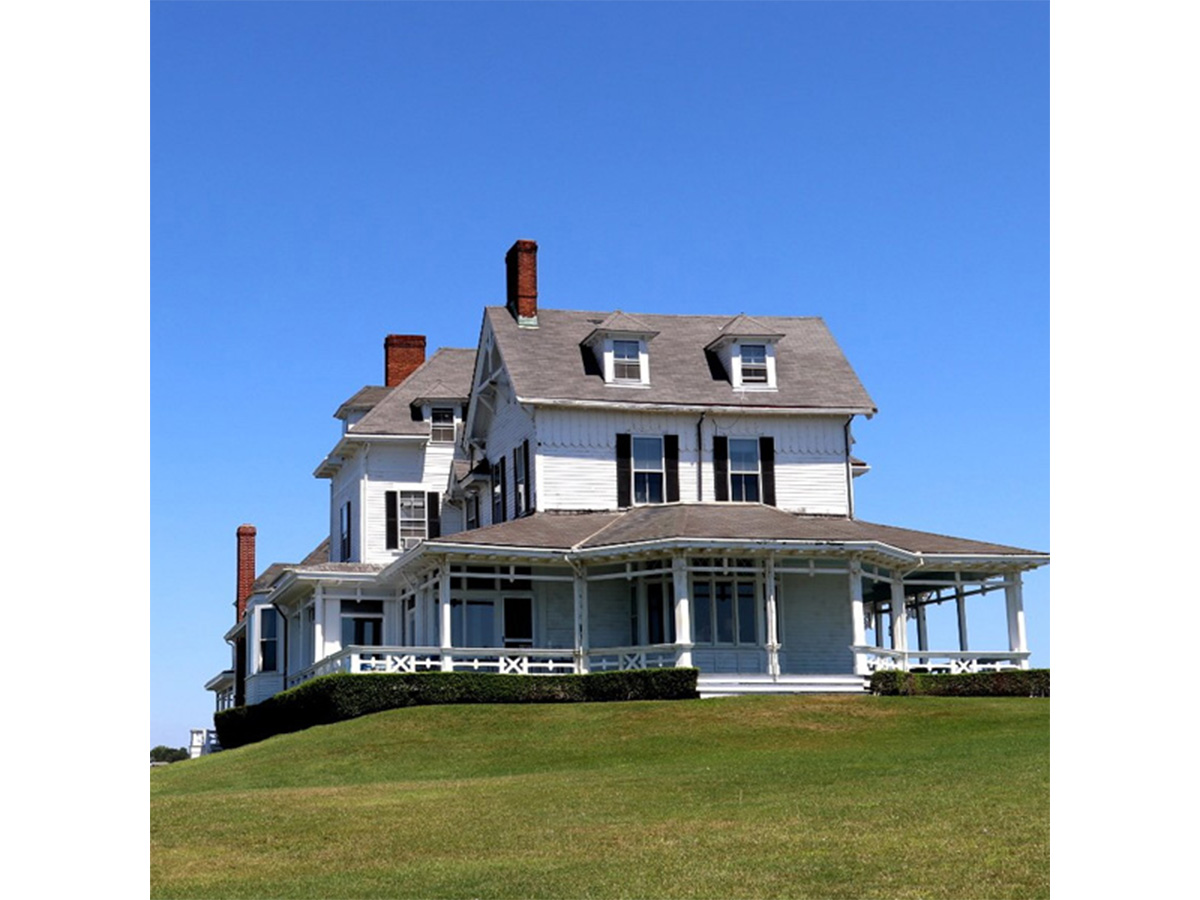
Cushing Family Compound (John Hubbard Sturgis, 1867)
- Also known as “The Ledges”, this house belonged to a Boston family made rich in the China Trade in the early 19th century.
- It is a Modern Gothic house with a stone foundation and a complex cross-gable-roof. Its design is a large, elegant, Stick style cottage, with plenty of room for entertainment and family.
- The wraparound strut work porch on the east, south, and west elevations, with semi-octagonal-plan bay centered on its south elevation, and three prominent brick chimneys.
- A large modern 2-story, L-plan, hip-roof addition extends north from the west end of the north elevation.
- Now 150 years later, Robert Cushing’s descendants still own the estate. It is relatively unchanged, featuring original furnishings, beautiful, papered walls, and the artwork of the original owners.
47 – William S. Miller House

William S. Miller House (Warren and Wetmore, 1900)
- Also known as “High Tide”, this home aims to feel like a rustic villa in the French countryside.
- Arched-topped windows and stucco masonry walls of this mansion, along with six tall parged chimneys extending from the roof of the main block.
- The centerpiece of this 7.5-acre estate is the main house with its multi-gabled roof, lots of chimneys, and L-shaped plan to exploit views overlooking Bailey’s Beach and Almy Pond.
- The stucco and wood house appears vast, but the delicate architectural details and decoration gives the rooms a more intimate scale.
- High Tide’s real prominence derives from its site, overlooking the entire rocky shoreline and the Atlantic beyond. It is situated the house on an elevated lot building it into the sloping land, with the basement story fully exposed on the east and north elevations.
48 – Wrentham House
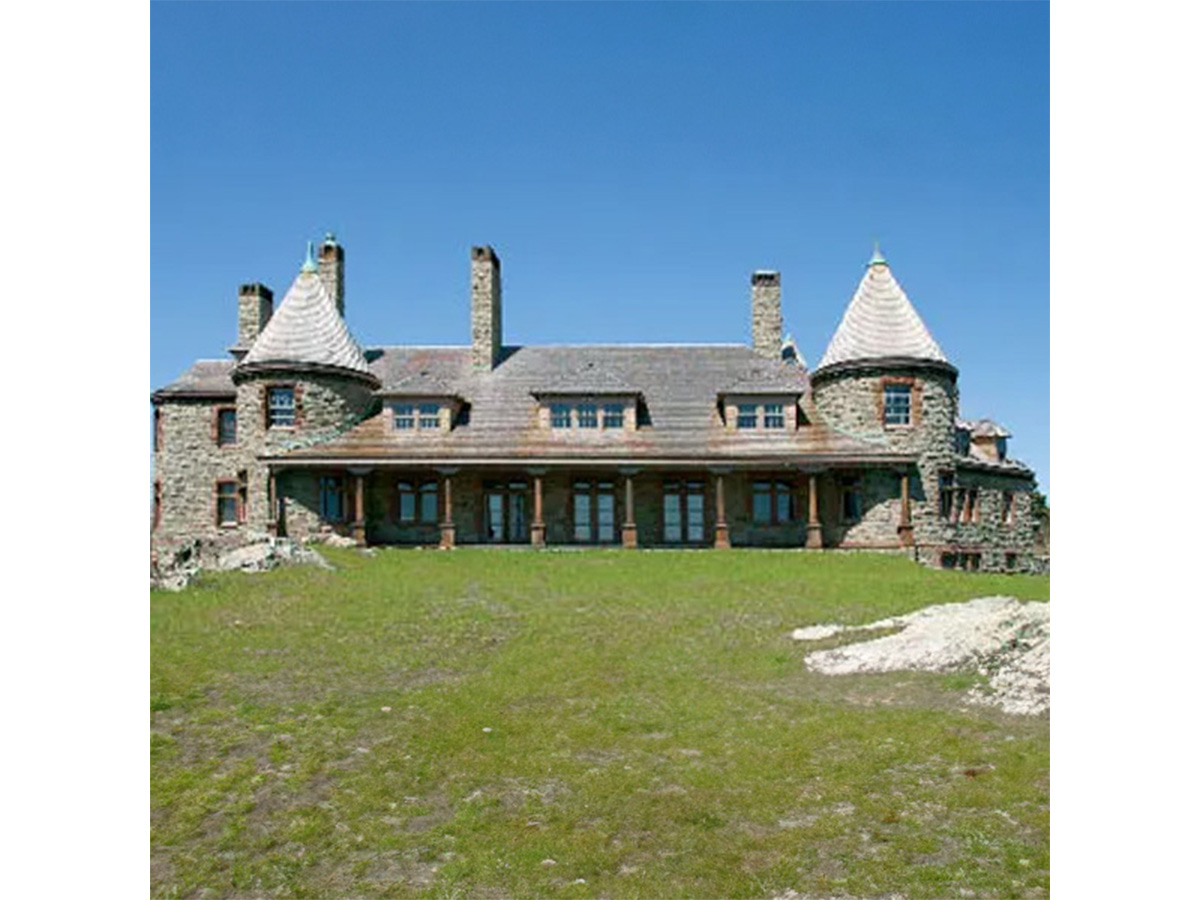
Wrentham House (Richard Morris Hunt & Fredrick Law Olmstead, 1887-1892)
- Also known as “Indian Spring”, the granite-and-brownstone castle was a collaboration between two of the greatest designers of the day.
- With elements of Queen Anne Style, a sweeping 1.5-3.5-story, L-plan, high-hip-roof, ashlar Romanesque house with lower service wing. The principal entrance, set within a low roundhead relieving arch which faces a large walled court.
- The house’s most striking aspect is its ocean-facing broad-7-bay porch set within the mass of the main block between 2 towers. The 3 central bays of the porch are centered on French doors, and 3 broad hip-roof dormers are symmetrically arranged on the sweeping roof above.
- Because of the abrupt change in grade, the west end of the main block rises 3.5 stories. The house is masterfully sited atop a rock outcropping, and both siting and design beautifully integrate building and site: the planting scheme here achieves significance, not only for what is planted but more importantly for what is not planted, with absence of foundation planting emphasizing the organic relationship between the natural and the created.
Abandoned and left to decay for 40 years, the house was painstakingly restored from 2000-2007.
49 – The Reef Estate
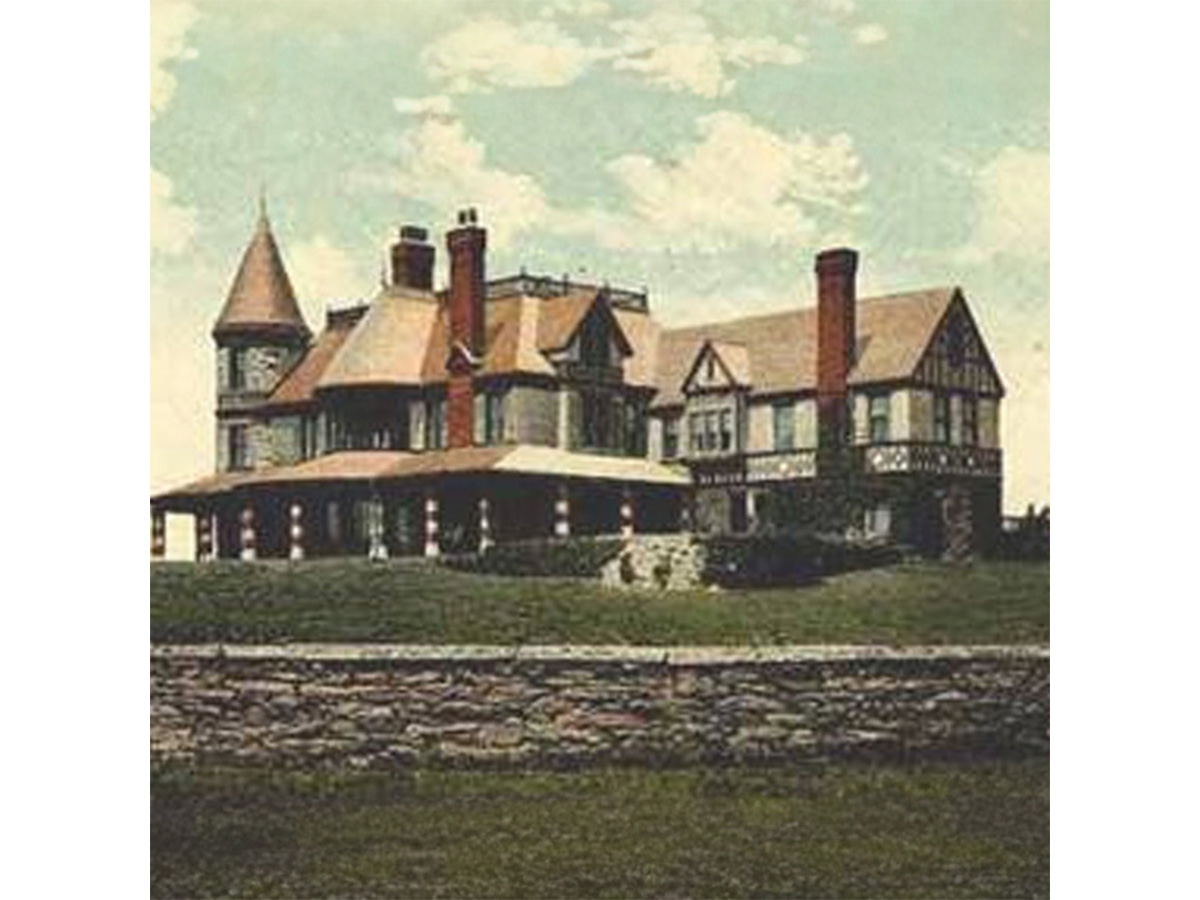
The Reef Estate (Sturgis and Brigham, 1885) Brenton Point State Park
- This building is among the hundreds of mansions lost to demolition.
- Also known as “The Bells”, this gilded mansion had a history of neglect for a historical building and was left uninhabited by the family for close to 100 years.
- The elegant shingles and stone of the Queen Anne villa were erected as both a summer house and to house some of Davis’s vast collection of paintings and Egyptian artifacts, collected during his excavations in Egypt’s Valley of the Kings between 1902 and 1913. Besides the architecture of the home, the Reef Estate was also famous for its walled gardens, greenhouses, and outbuildings, sitting upon eighteen acres.
- During World War II, anti-aircraft gun emplacements were set up around the house, which housed gunnery personnel. Vandalized throughout the 1950’s, the villa was set on fire in 1961 and demolished on May 25, 1963.
- In 1969, the waterfront property came under the control of the State of Rhode Island and in 1976, became a state park.
- The former servants’ quarters serve as an office for the park, the stone tower is now used as a viewing platform, and the final remains of the carriage house were recently demolished after being determined unstable.
50 – Castle Hill Inn

Castle Hill Inn (1874)
- This building is among the hundreds of mansions lost to demolition.
- Also known as “The Bells”, this gilded mansion had a history of neglect for a historical building and was left uninhabited by the family for close to 100 years.
- The elegant shingles and stone of the Queen Anne villa were erected as both a summer house and to house some of Davis’s vast collection of paintings and Egyptian artifacts, collected during his excavations in Egypt’s Valley of the Kings between 1902 and 1913. Besides the architecture of the home, the Reef Estate was also famous for its walled gardens, greenhouses, and outbuildings, sitting upon eighteen acres.
- During World War II, anti-aircraft gun emplacements were set up around the house, which housed gunnery personnel. Vandalized throughout the 1950’s, the villa was set on fire in 1961 and demolished on May 25, 1963.
- In 1969, the waterfront property came under the control of the State of Rhode Island and in 1976, became a state park.
- The former servants’ quarters serve as an office for the park, the stone tower is now used as a viewing platform, and the final remains of the carriage house were recently demolished after being determined unstable.
51 – Castle Hill Lighthouse
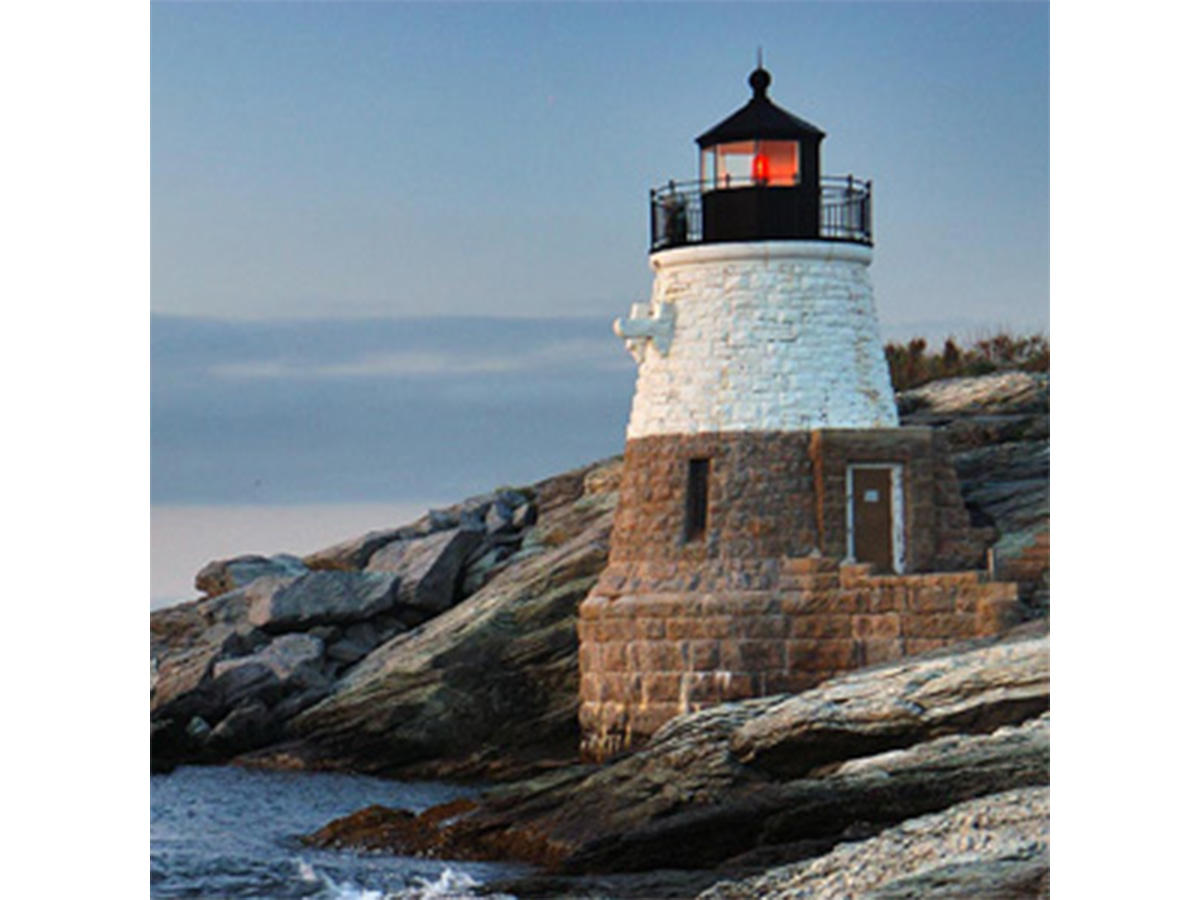
Castle Hill Lighthouse (Henry Hobson Richardson, 1898)
- Castle Hill Lighthouse is located on Narragansett Bay, at the end of the historic Ocean Drive.
- Active navigation aid for vessels entering the East Passage between Conanicut Island and Aquidneck Island and is a symbol of Newport.
- The lighthouse is closed to the public, but the grounds are not, there is a series of stairs leading to the lighthouse.
- During In 2021, Castle Hill signed a five-year agreement to maintain the castle Hill Lighthouse.
The lighthouse was inducted into the National Register of Historic Places in 1988.
52 – Hammersmith Farm

Hammersmith Farm (Robert H. Robertson, 1887)
- William Brenton, the second governor of RI, established the farm on the site it 1640, calling it “Hammersmith Island”
- Anchored by a Victorian era mansion, embodies the architectural grandeur of Newport
- In 1887, Robert H Robertson designed a 28-room Victorian Mansion, commissioned by John W. Auchincloss
- A quintessential blend of Queen Anne revival and shingle style that became the Kennedy “Summer Whitehouse”.
53 – Eisenhower House

Eisenhower House (George Champlin Mason & Son, 1873-1874)
- The Eisenhower house was once the summer white house for President Dwight D. Eisenhower during his presidency in 1958 and 1960.
- A wooden framed house, typical of the era, it features many hallmarks of the American Queen Anne style.
The Eisenhower House was added to the National Register of Historic Places on May 8, 1974, and was designated a National Historic Landmark on July 28, 1970.
54 – Fort Adams State Park

Fort Adams State Park (Simon Bernard & Joseph G. Totten, 1824-1857)
- An idea originally thought up during the revolutionary war to protect the three passages into Narragansett Bay, this fort was originally planned for Goat Island.
- The “third system” was the third stage in the defense plan of America’s coasts, beginning in 1821. It called for a variety of defenses to the three passages of Narragansett Bay, with Fort Adams at Brenton Point being the farthest along.
- Fort Adams is a massive work with structural walls constructed of local shale and Maine granite. The fort has a perimeter wall running almost three quarters of a mile in a pentagon shape, granite scarps, brick vaults, and share and earth fill.
- An irregular pentagon shape was chosen with the northeast bastion particularly squeezed to accommodate the nature of the site.
- As military technological developments improved, the fort became less and less relevant in costal defense, the State of Rhode Island took possession of Fort Adams for use as a state park in 1965. It was added to the National Register of Historic Places in 1970, and later to the National Historic Landmarks on December 8th, 1976.
55 – Beacon Rock (Marion Eppsley House)
Beacon Rock (Marion Eppsley House) (McKim, Mead, & White, 1889-1891)
- This Beaux Arts-style villa was designed by MMW for Marion Eppsley to overlook the Newport Harbor and Brenton Cove.
- Captain Eppley, a Princeton graduate who served in both World Wars, was a physical chemist and research scientist.
- Beacon Rock was called the Acropolis of Newport, as it was designed on the plan of the ancient Athenian Stoa of Attalus and the Agora adjoining it. The resulting ionic marble colonnades and the balanced, matching temple-like facades took over 3 years to complete.
- A new era began in 1951 when Mr. Felix DeWeldon, the world-renowned sculptor, took possession. Here, he undertook one of his greatest and most famous works, the flag raising on Iwo Jima. Today, it is officially known as the United States Marine Corps War Memorial, displayed in Arlington National Cemetery.
- It is a private residence.
56 – Harbour Court (New York Yacht Club)
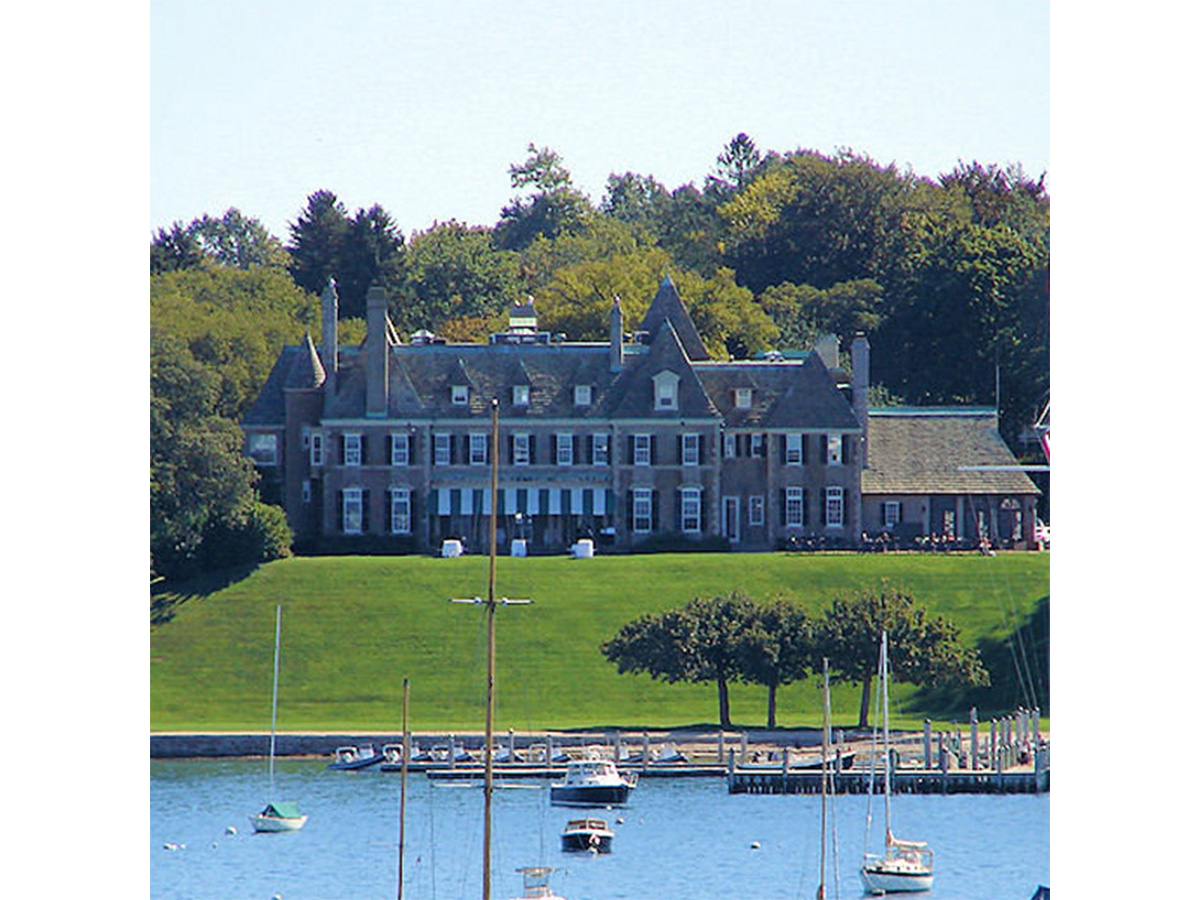
Harbour Court (New York Yacht Club) (Cram, Goodhue, & Ferguson, 1901)
- This Renaissance Norman-style mansion was designed by Ralph Adam Cram. It was modelled for the most part after the family’s French ancestral seat in Normandy, Chateau d’Osmoy. On the site of a previous waterfront villa “Riviera” before its demolition.
- It became the summer house of the Brown family, an extremely prominent name in Newport and the namesake for Brown University in Providence.
- In 1915, Mrs. Brown extended the house with a two-story addition on its east side that included a conical tower and a “sleeping porch” for the benefit of her teenage son’s constitution. After Mrs. Brown died, her son enclosed the porch and transformed it into a bathroom that made the most of its spectacular views across the water.
- Starting in 1988, it was the first large permanent waterfront facility for the club that was based out of New York up until this point. There were smaller outposts in the Long Island sound. The facility became the national- and international-focal point of many of yachting’s premier events.
John Brown II was elected Commodore of the New York Yacht Club (1952-1954), the Ida Lewis Yacht Club and the Newport Yacht Club. He would have been happy with the eventual use of his childhood home, as he had often mused that it would make a good clubhouse.
57 – Ida Lewis Yacht Club

Ida Lewis Rock Lighthouse (1854)
- Originally known as the “Lime Rock Lighthouse” this lighthouse was built on the largest of a series of outcroppings about 900 feet from the Newport shore.
- A two-story cottage was erected on Lime Rock the following year using granite and brick, and a brick tower was built into one corner of the structure for displaying the light from a sixth-order Fresnel lens. Ida and her family moved into the lighthouse on June 29, 1856.
- During her years at the Lime Rock Light, Ida Lewis saved over a dozen people from drowning. Ida became nationally known in 1869, when an article about her saving two soldiers appeared in Harper’s Weekly.
- A light on a skeleton tower replaced Ida Lewis Lighthouse when it closed in 1927. It remained in service until 1963, when it was deactivated. The land and building were sold in 1928 to the “Narragansett Bay Regatta Association”.
- It was later turned into the Ida Lewis Yacht Club. Around this time, a boardwalk was built connecting the mainland to the rock.
The lighthouse was included in the National Register of Historic Places on February 25th, 1988.
58 – Emmanuel Church
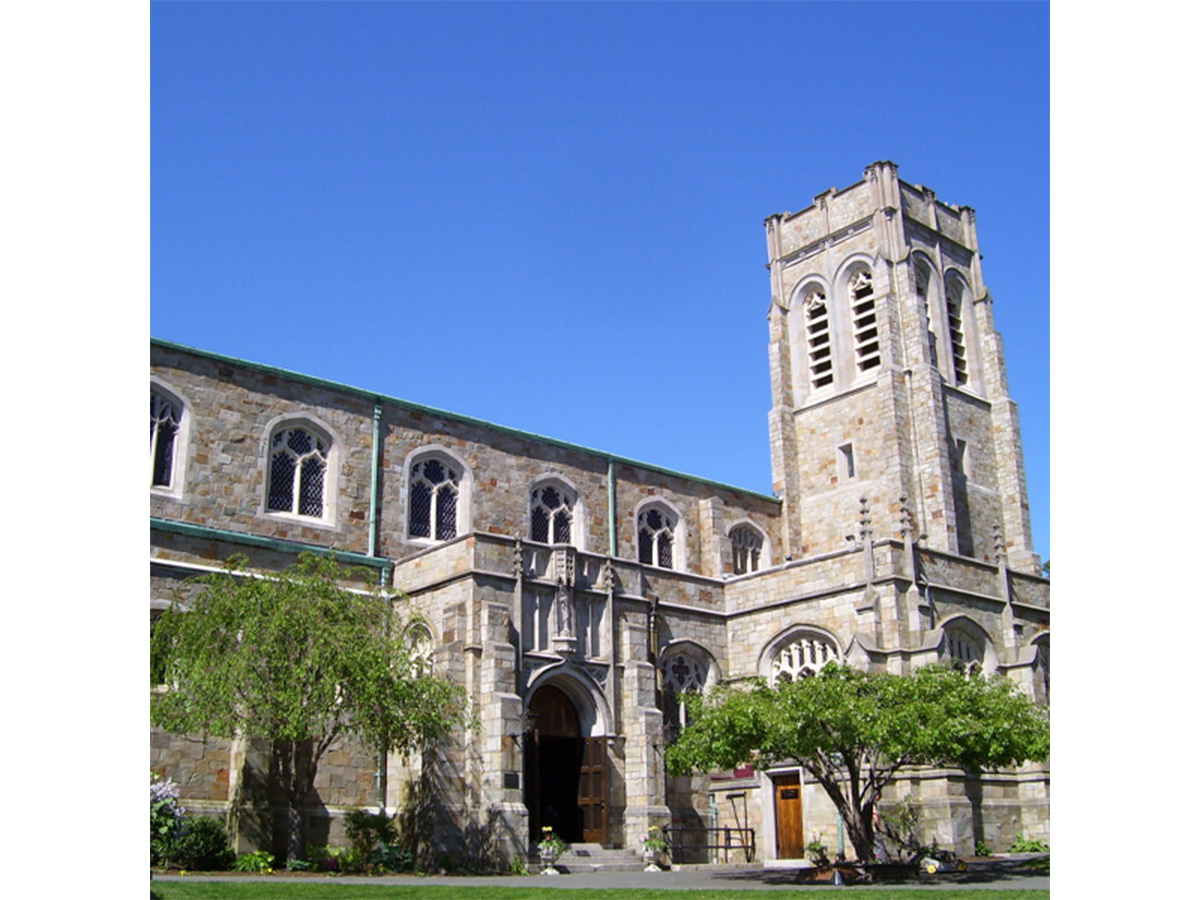
Emmanuel Church (Cram, Goodhue, & Ferguson, 1903)
- Originally established in 1841 by three women from Trinity Church who lived in the fifth ward, the church was constructed for those who could not pay for pew seats.
- The current building was designed by architect Ralph Adam Cram and Goodhue & Ferguson in Late Gothic Revival style as a memorial to John Nicholas Brown by his widow.
- It has long been known as “the church of the people,” where “rich and poor, high and low, great and humble all worship and work together as friends.”
- When the original wood building began to decay, it was replaced with the current stone building by donations from widow Natalie Bayard Brown in memory of her husband.
It was added to the National Register of Historic Places on May 16th, 1996.
59 – Edward King House
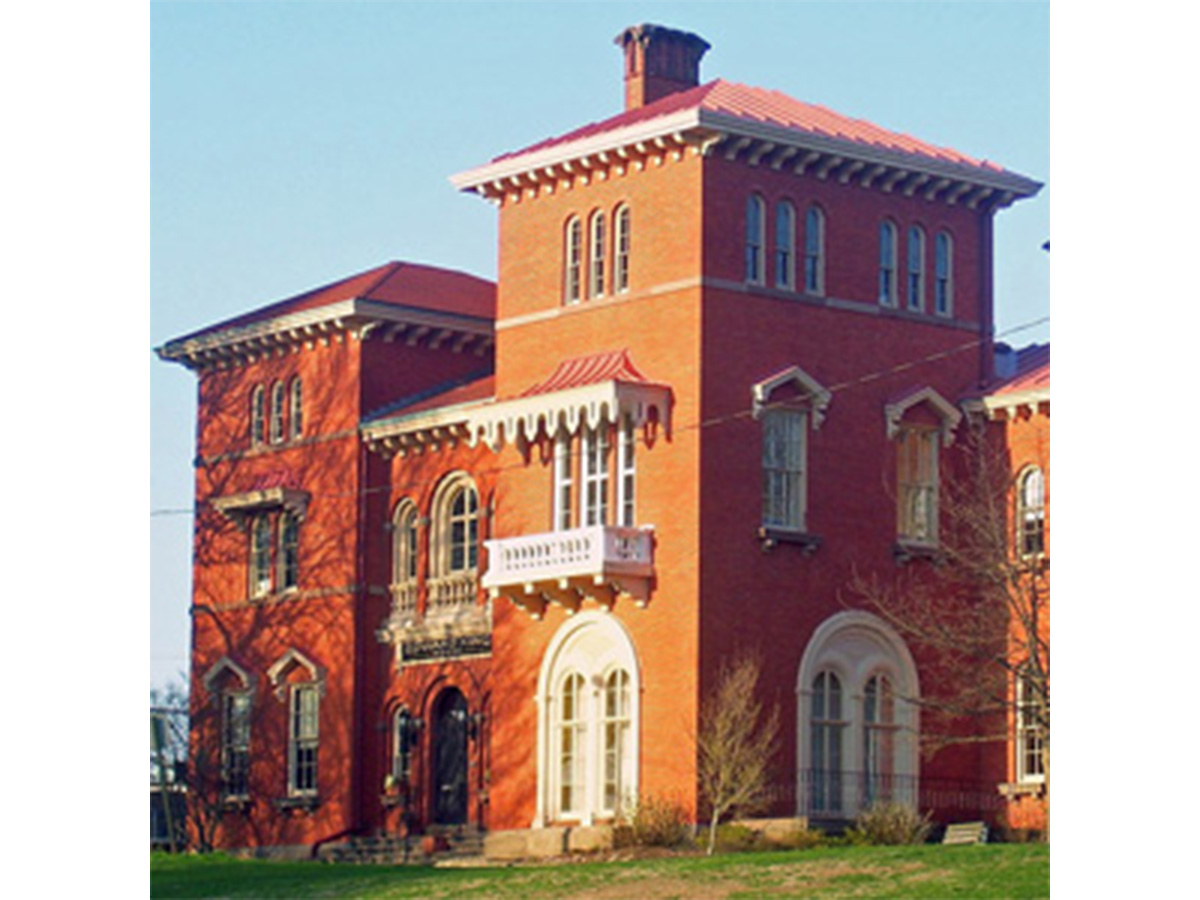
Edward King House (Richard Upjohn, 1845-47)
- It was designed by Richard Upjohn for Edward King in the Italianate style, and one of the earliest representations of the style, as well as being the largest and grandest house in Newport at the time of its construction.
- The house was built in brick, has asymmetrical massing, arched windows heads and a prominent three-story tower.
- The house was featured in Andrew Jackson Downing‘s The Architecture of Country Housesin 1850, including an engraving of the house and architectural plans. Downing described the house as “one of the most successful specimens of the Italian style in the United States.”
- The current building is now owned by the city of Newport and serves as a senior citizen center.
It was added to the National Register of Historic Places on October 15th, 1970, and it was designated a national historic landmark on December 30th, 1970.
60 – St. Mary’s Church
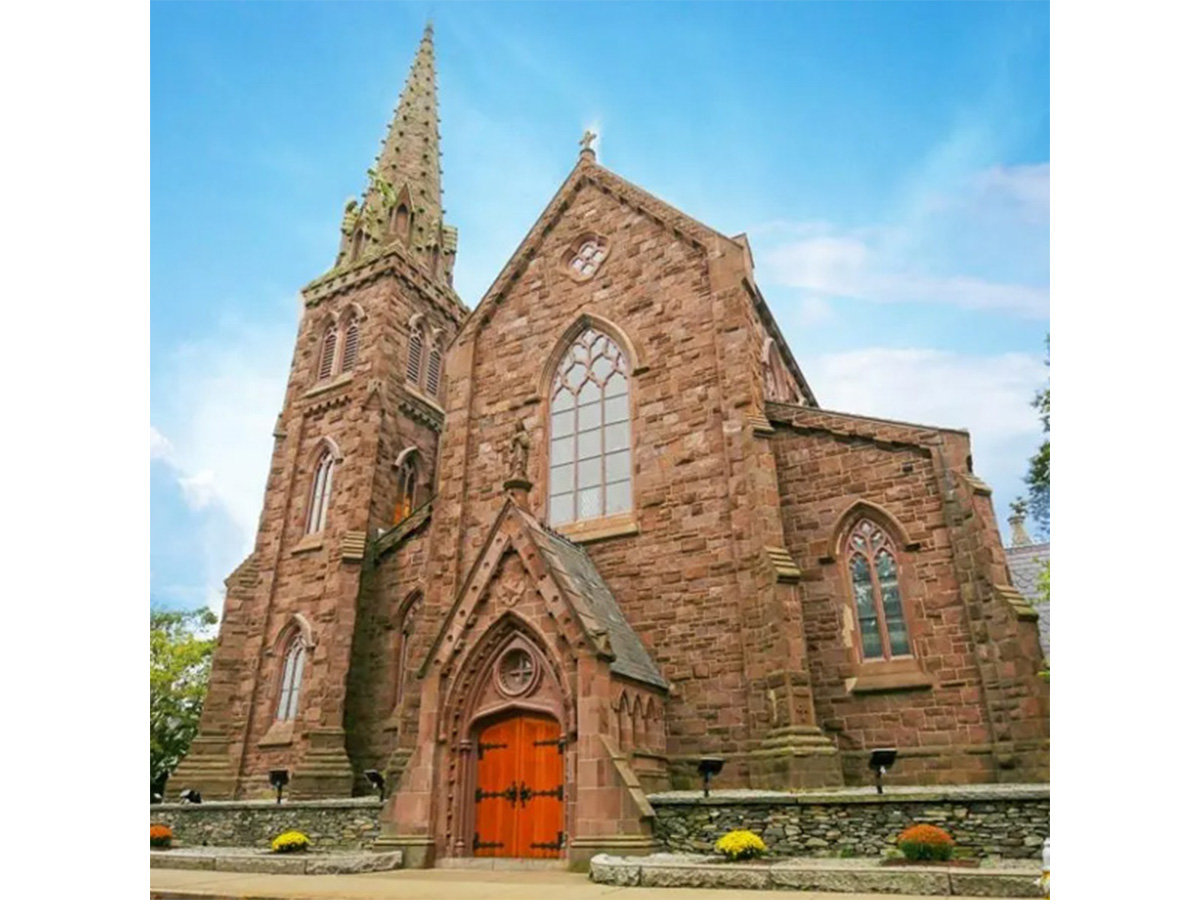
St. Mary’s Church (Patrick C. Keely, 1848-52)
- Officially the Church of the Holy Name of Mary, Our Lady of the Isle, this is home to Rhode Island’s oldest Catholic parish.
- The parish was established in 1828 to serve Newport’s growing population of Catholics, many of whom were Irish immigrants working on the construction of nearby Fort Adams.
- The Gothic Revival style building you see today
- Three buildings comprise the complex: the brownstone Gothic Revival parish church; the parish house (formerly a school), and a convent.
- This church hosted the wedding of Jacqueline Bouvier and Senator, later President, John F. Kennedy in 1953.
This church complex was added to the National Register of Historic Places on March 6th, 2008.
61 – Clarke Cooke House
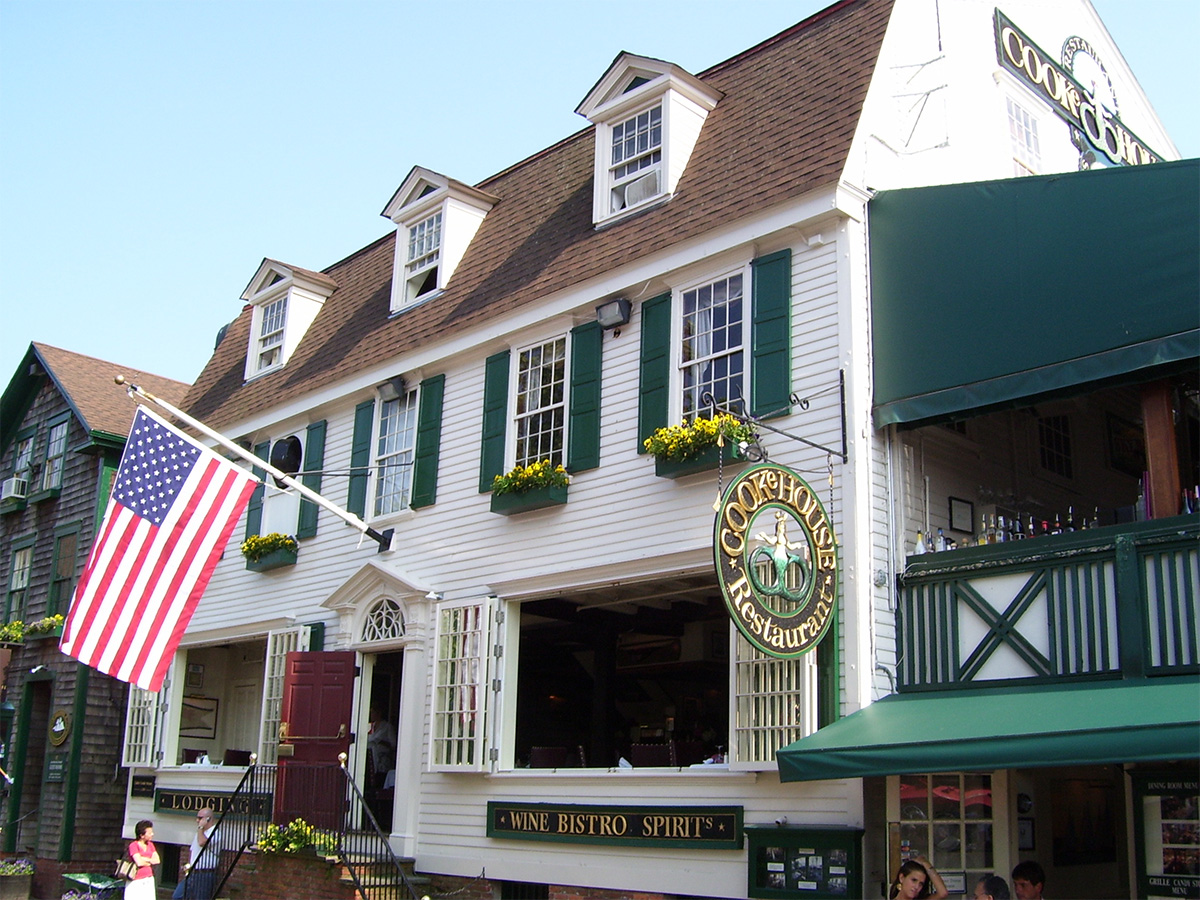
Clarke Cooke House (Benjamin Clarke, 1785)
- Colonial era building relocated when America’s Cup Blvd. was built
- Originally built in 1785 by Benjamin Clarke
- The restaurant has been a part of Newport’s vibrant community and is known for its association with the social scene
- The building was moved in 1973 to Bannister’s Wharf
62 – Queen Anne Square

Queen Anne Square (Maya Lin, 1970)
- Where 1770 colonial-era buildings were burned by the British or demolished
- In 1973, Doris Duke elected to relocate anu remaining structures on the parcel, creating a park with trees, boulders, and flower beds
- In 2011 artist, Maya Lin, and landscape architect, Edwina von Gal, re-designed the park entirely
- The footprints of previous foundations are recreated at seating height to create a dynamic, yet historical architectural planning for the park.
63 – Trinity Church
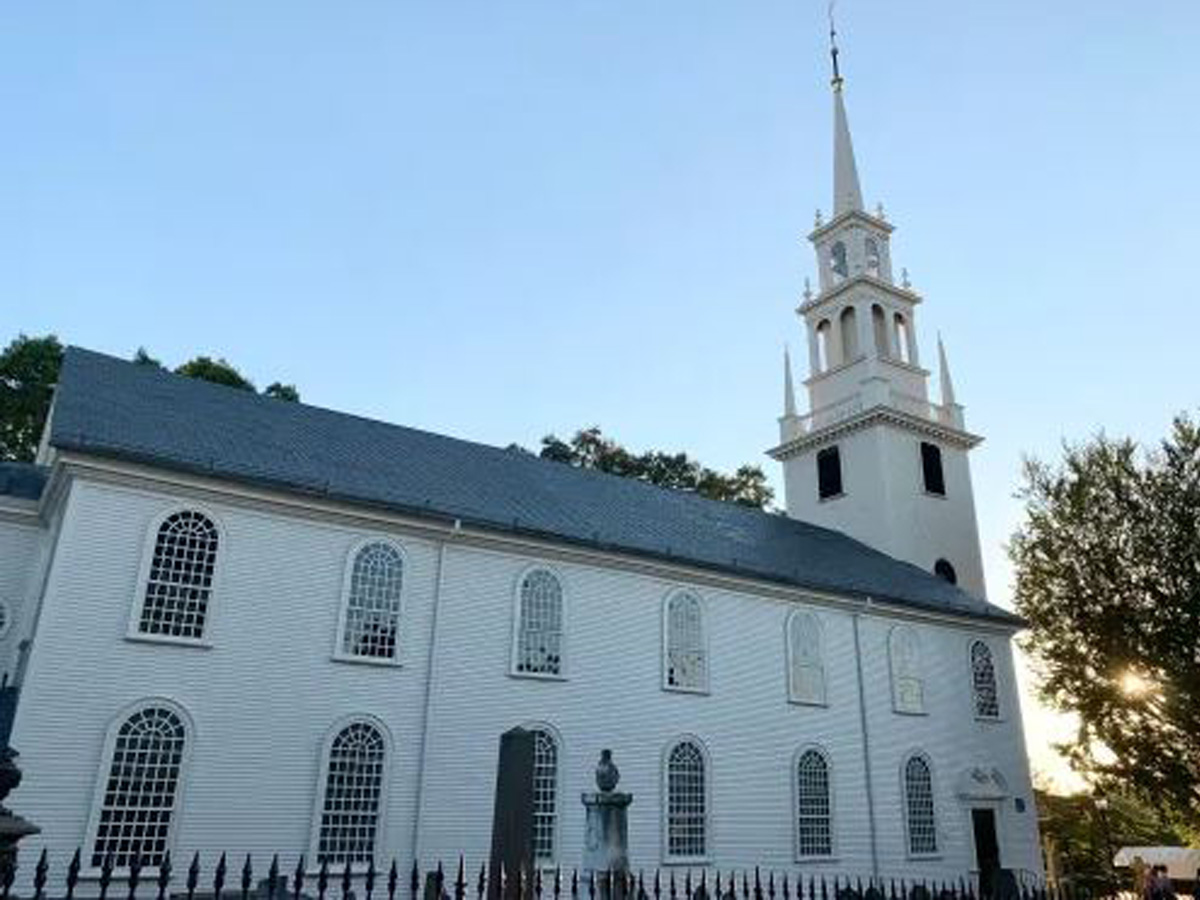
Trinity Church (Richard Munday, 1743)
- Located in Queen Anne Square
- Historic Parish church in the Episcopal Diocese of Rhode Island
- The oldest Episcopal parish in the state
- The church is a classical colonial Georgian style, characterized by its symmetrical façade and simple lines.
- The church is known for its distinctive steeple and traditional interior reflecting the colonial heritage of the region.
Designated a National Historic Landmark in 1968.
64 – America’s Cup Boulevard / Gateway Center

America’s Cup Blvd. (1970’s) / Gateway center (1974)
- Named after the America’s Cup yacht races held in Newport from 1930 to 1983.
- Originally designed to favor vehicular traffic, separating the wharves and colonial Newport, the boulevard now favors pedestrians as well
- Failed urban design initiative. Efforts of past 30 years have been to correct the problems it created.
- Transportation connection to downtown Newport at the end of America’s Cup Blvd.
- Featuring more modern architectural features
65 – The Pell Bridge
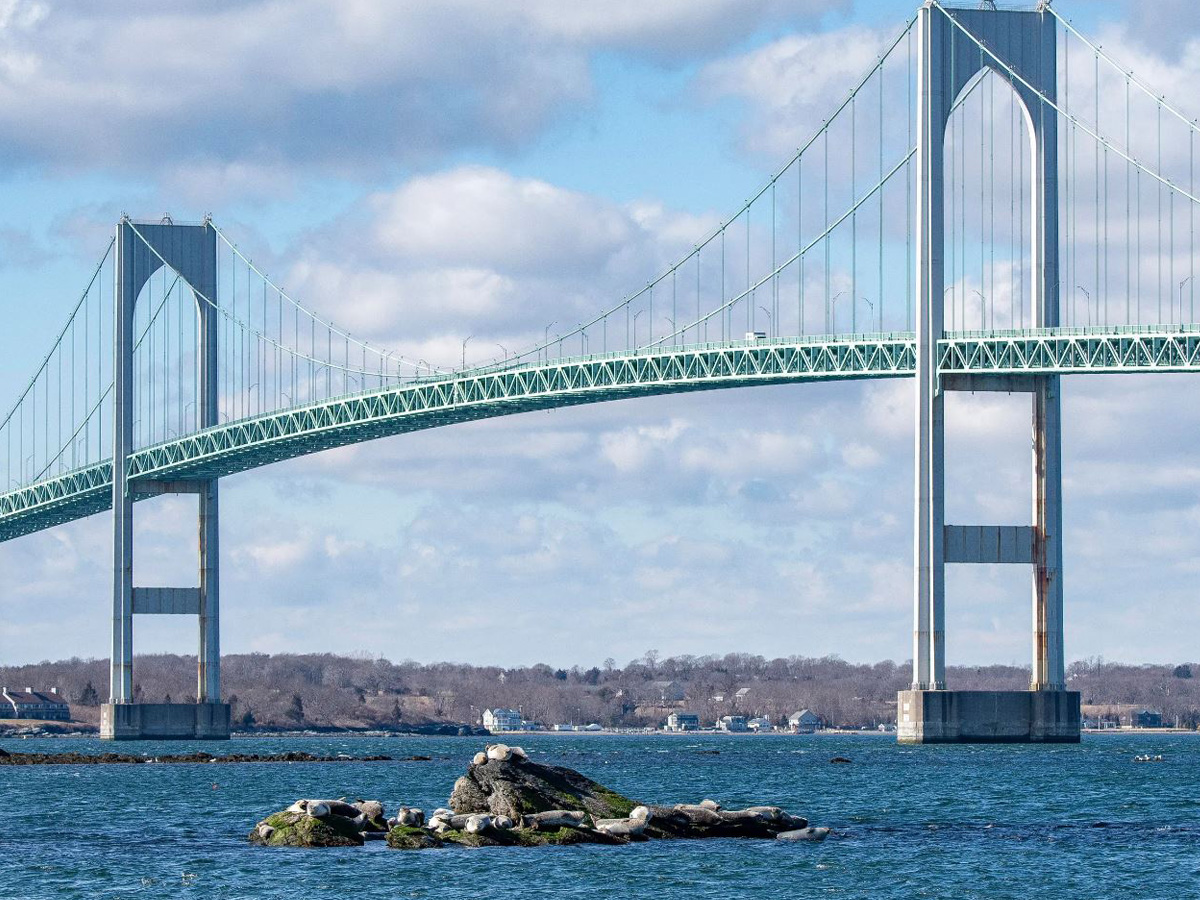
The Pell Bridge (1969)
- Named after Claiborne Pell, a US senator from Rhode Island
- Changed the connectivity between the region between Newport and Jamestown
- Span of 1,600 feet, a major engineering project at the time
Ross Cann, RA, AIA, LEED AP, is an author, historian, teacher and practicing architect living and working in Newport, RI. He holds degrees in Architecture and Architectural History from Yale, Cambridge, and Columbia Universities. He is a Leadership in Energy and Environmental Design Accredited Professional.
